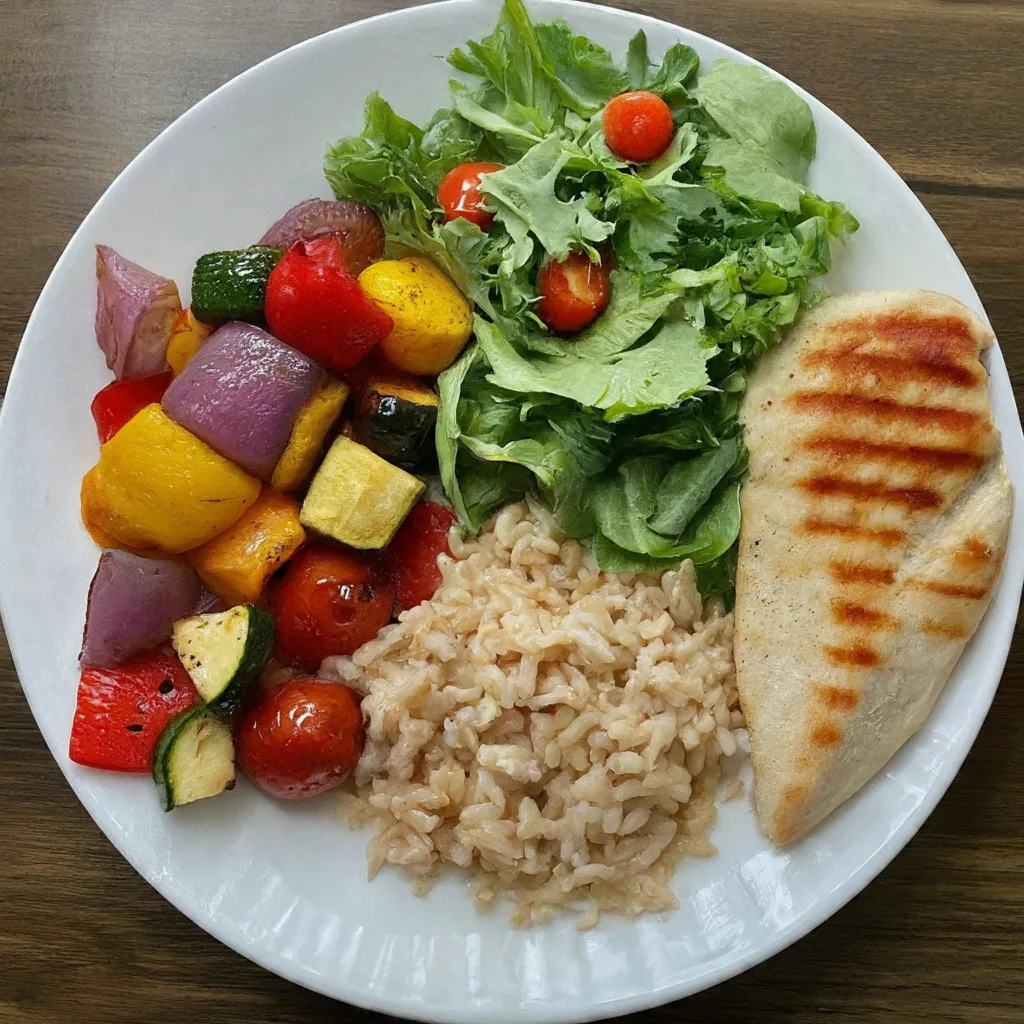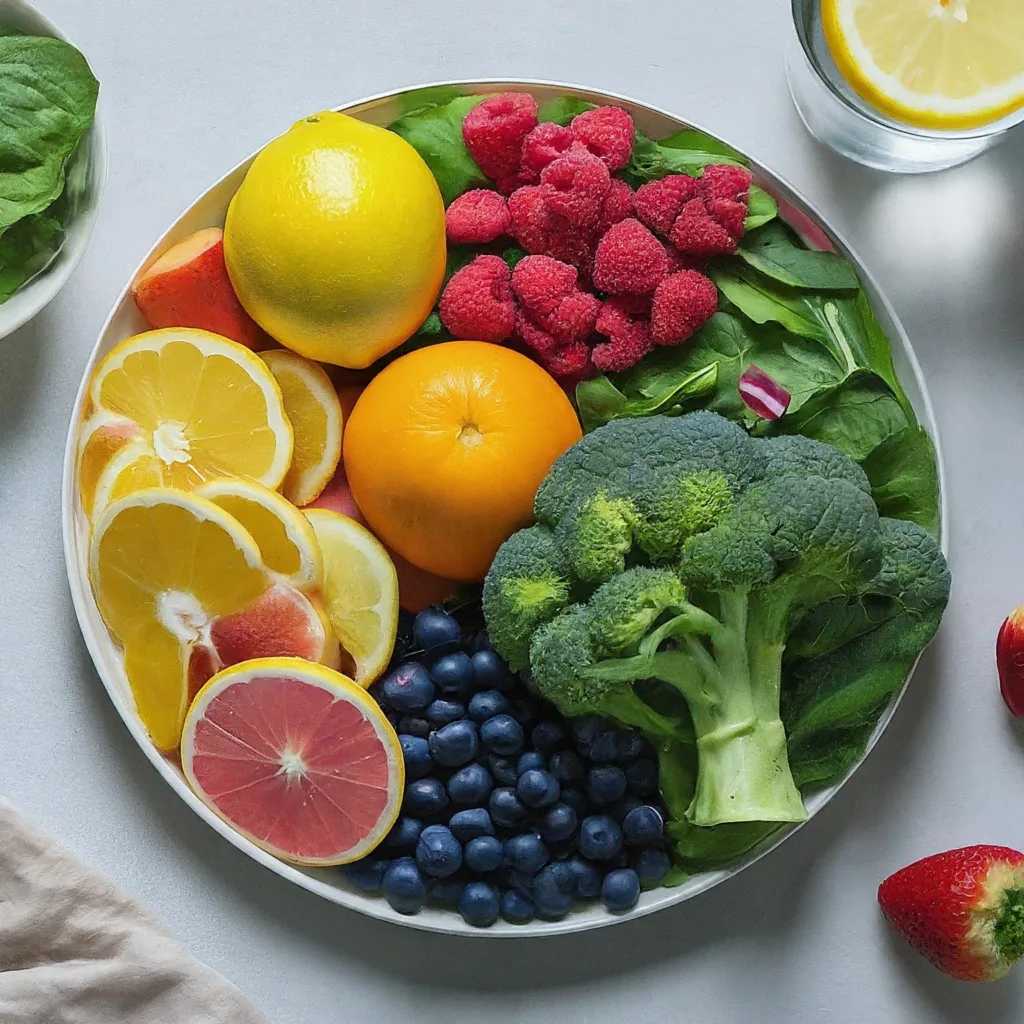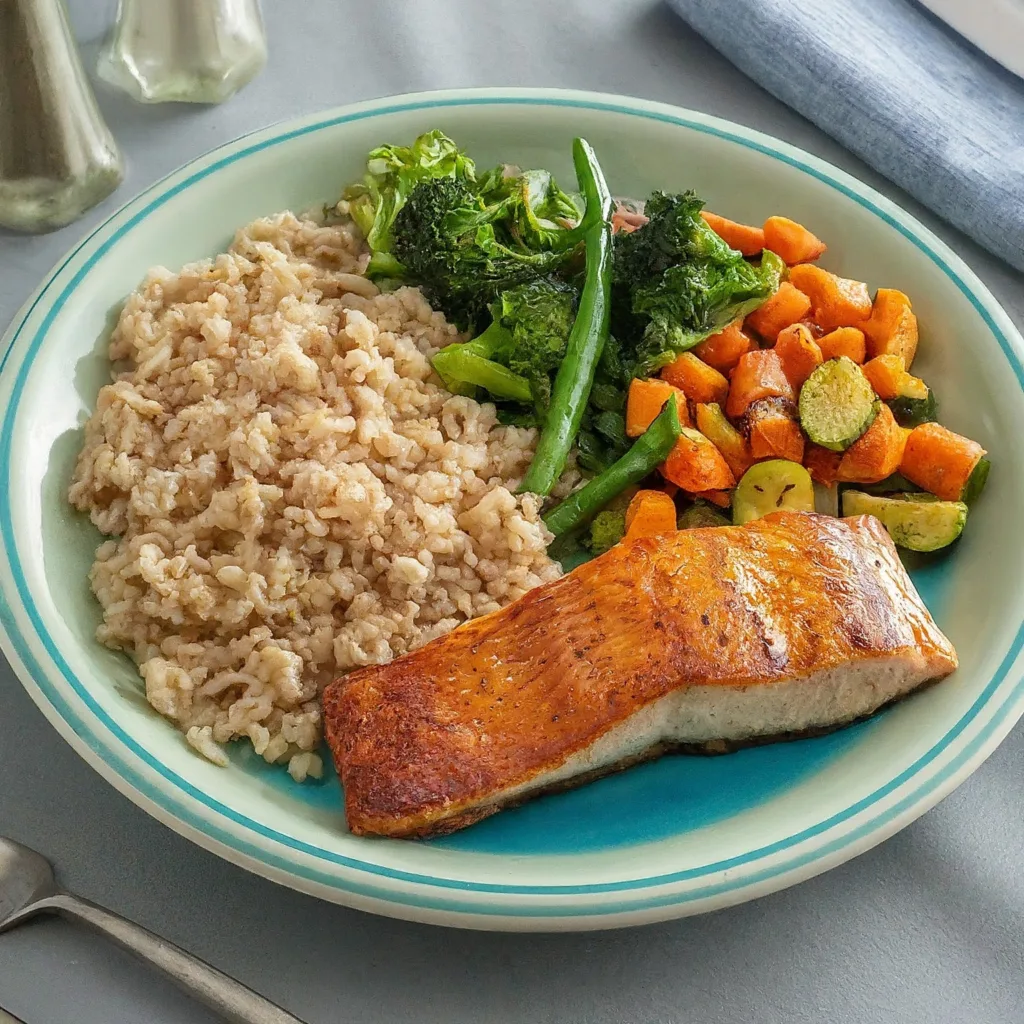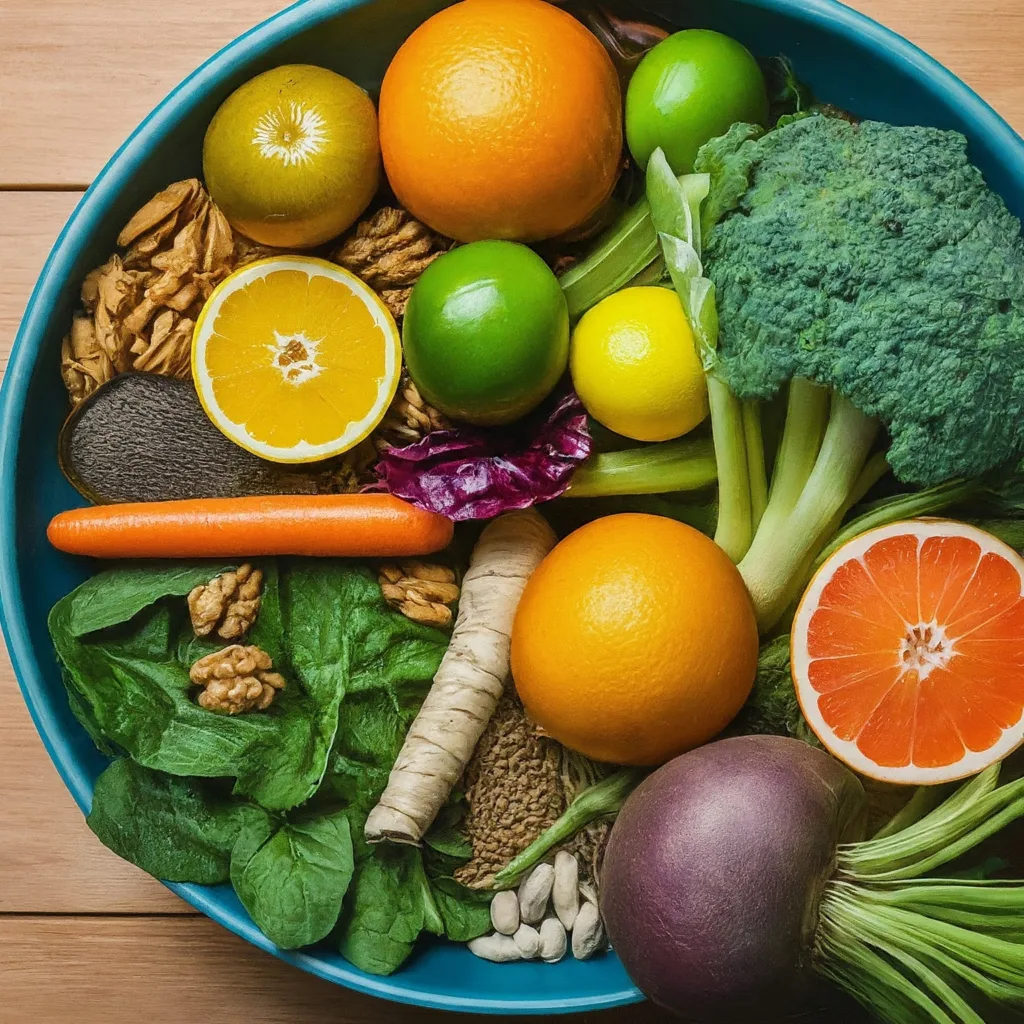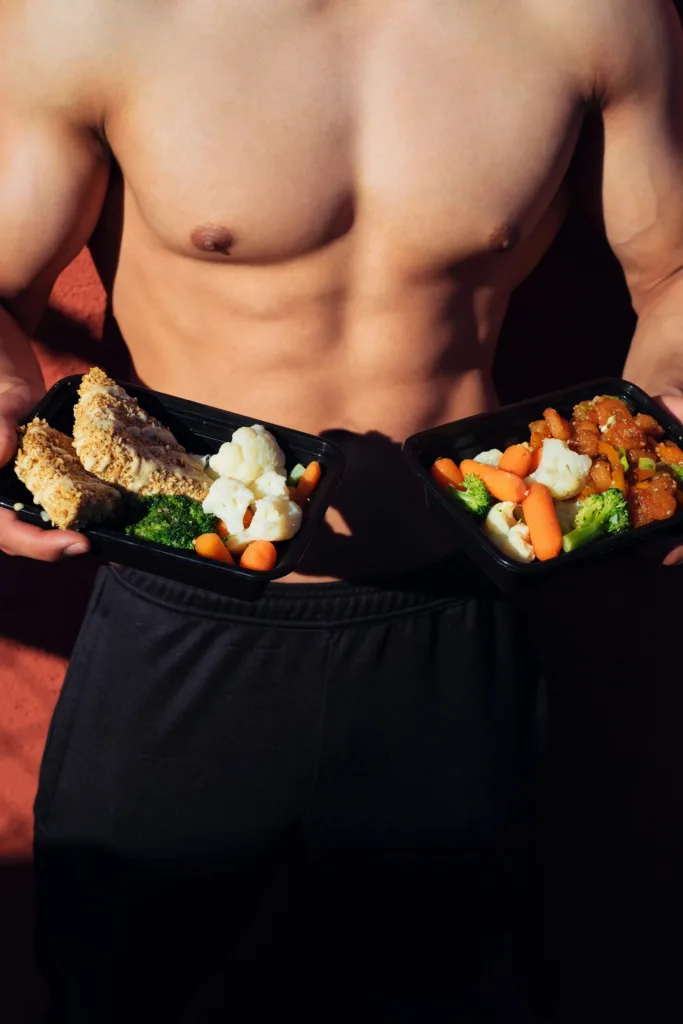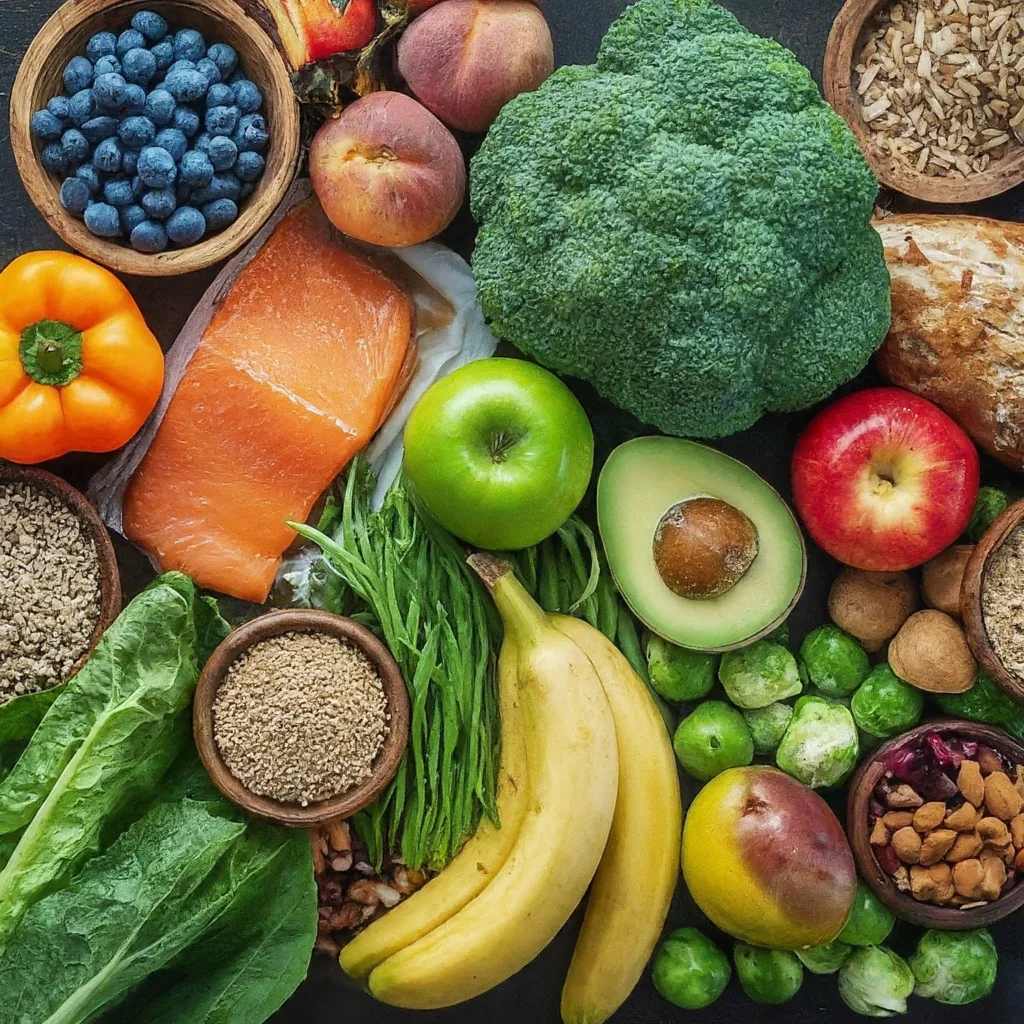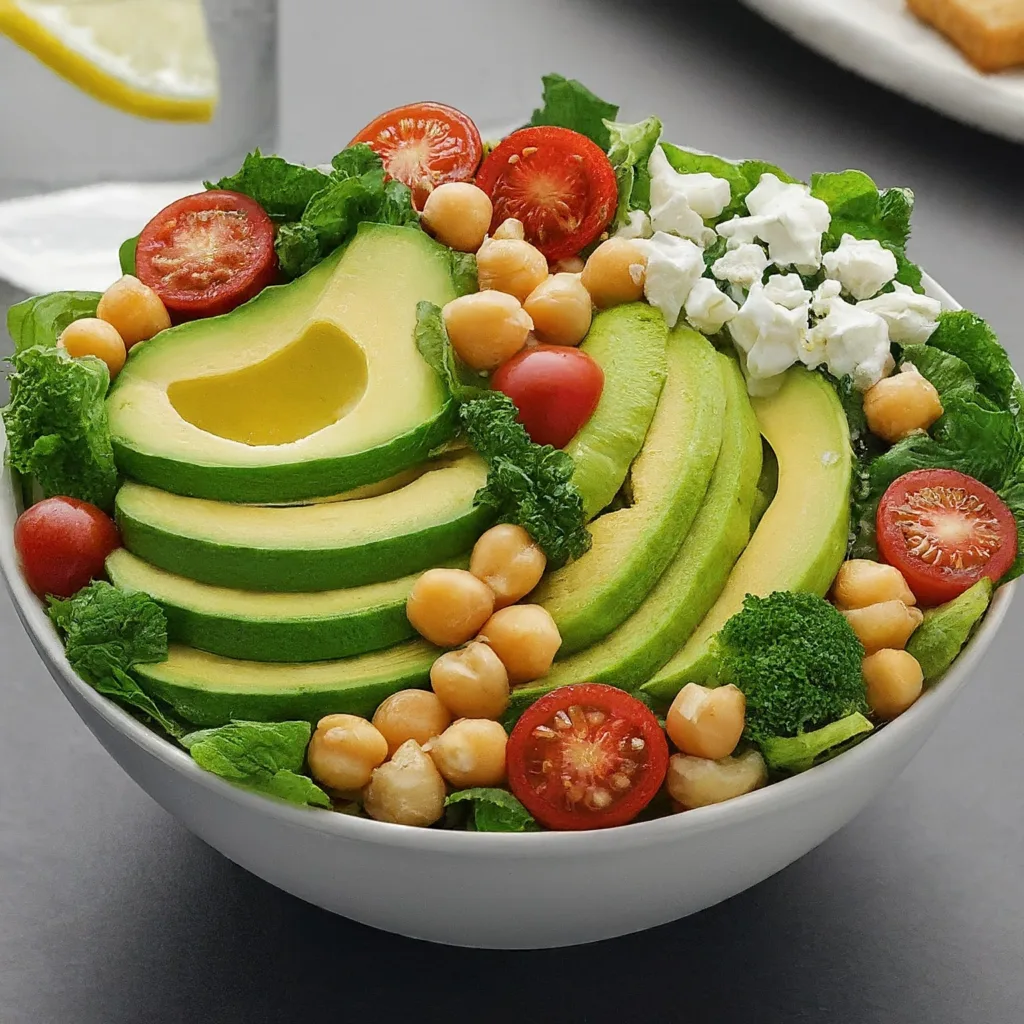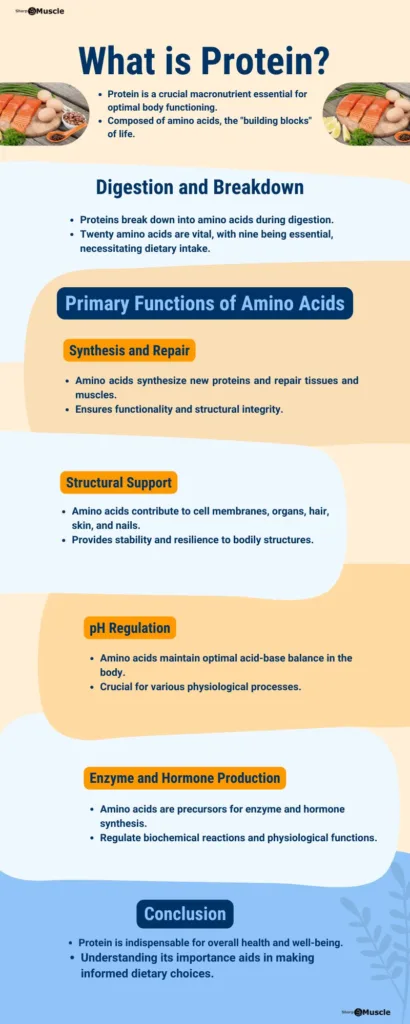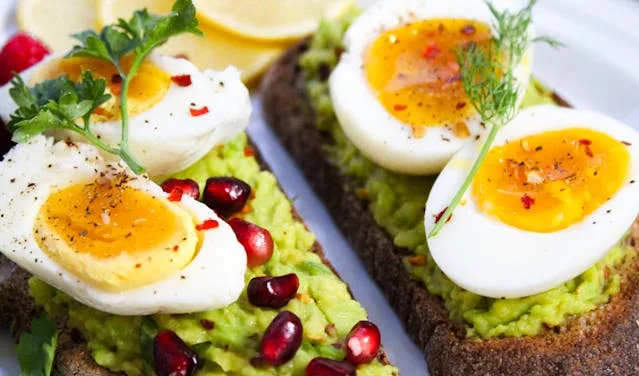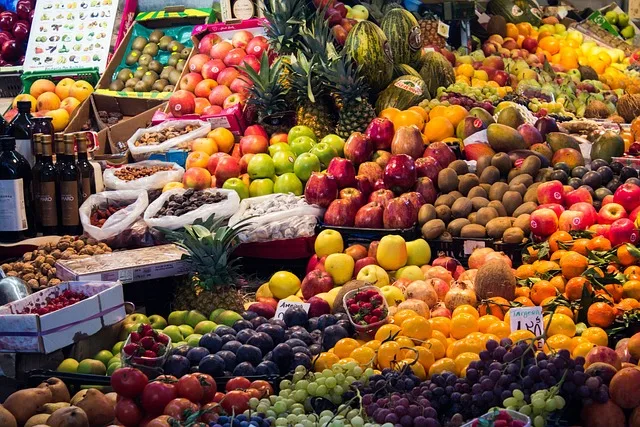Are you tired of fad diets that leave you hungry and unsatisfied? Ready to ditch the deprivation for a sustainable way to reach your weight loss goals? Our 1700-calorie diet plan for weight/fat loss is the solution you’ve been seeking. This balanced and delicious approach focuses on nourishing your body while creating the calorie deficit needed for healthy weight loss.
In This Article
Understanding the Basics of a 1700-Calorie Diet
A 1700-calorie diet is a structured eating plan that restricts daily calorie intake to approximately 1700 calories. This calorie level is often chosen for individuals aiming to lose weight or manage their weight effectively.
How Does It Aid in Weight/Fat Loss?
The primary concept behind weight loss is creating a calorie deficit. Research has shown that reducing calorie intake can lead to weight loss by creating a calorie deficit, where the body burns more calories than it consumes. 1 2
A 1700-calorie diet helps achieve this by:
- Reducing Caloric Intake: For many individuals, 1700 calories may be less than their typical daily intake, leading to a natural calorie deficit.
- Boosting Metabolism: Regular, balanced meals keep your metabolism active and help your body burn calories more efficiently.
- Promoting Satiety: By focusing on whole, nutrient-dense foods, this diet plan helps you feel fuller for longer, reducing the urge to overeat.
Setting the Stage
Before diving into your 1700-calorie diet plan, it’s crucial to personalize your approach for maximum success. Consider factors such as your current weight, desired weight, and timeline for achieving your goals.
Let’s break it down:
1. Assessing Your Weight/Fat Loss Goals
Set achievable (Specific, Measurable, Achievable, Relevant, Time-bound) goals can help you stay focused and motivated throughout your weight loss journey. Aiming for a healthy weight loss of 1–2 pounds per week is sustainable and safe. 3 4
Think Beyond the Scale: Focus on overall well-being. Consider goals like increased energy, better-fitting clothes, or improved health markers.
2. Determining Your Caloric Needs
To effectively manage your weight, it’s essential to determine your daily caloric needs.
Several factors influence caloric requirements, including age, gender, weight, height, activity level, and metabolic rate. 5
- Online Calculators: Utilize tools like the SharpMuscle Calorie Calculator or Mayo Clinic Calorie Calculator to estimate your baseline calorie needs.
- Trial and Error: Start with a 1700-calorie plan and monitor your progress. Adjustments may be needed over time to find your ideal intake.
How to Find a More Personalized Calorie Target
Calculating your own calorie needs gives you a starting point for your 1700-calorie diet plan (or a different target). Here’s how:
Step 1: Calculate Your Basal Metabolic Rate (BMR)
What it is? BMR is the number of calories your body burns at rest, keeping your heart beating, lungs breathing, etc. 6 7 8
How to find it? Use a trusted online BMR calculator. Most require your age, gender, height, and weight. Search for “BMR calculator” and choose a reputable source (Mayo Clinic, etc.).
Step 2: Find Your Maintenance Calories
What it is? The number of calories you need to maintain your current weight, considering your activity level.
Calculate:
Multiply your BMR by an activity factor:
- Sedentary (little exercise): BMR x 1.2
- Moderately active (exercise 3-5 days/week): BMR x 1.5
- Very active (intense exercise most days): BMR x 1.7
Step 3: Create a Calorie Deficit for Weight/Fat Loss
The key to lose weight/fat is consume fewer calories than you burn.
- Aim for:
- 0.5-1 lb (0.2-0.45 kg) per week: Cut 250–500 calories from your maintenance level.
- Start slower, especially if you’re new to calorie tracking.
Example: A moderately active 22-year-old male, 5’8″, 160lbs with a BMR of 1700 calories:
- Maintenance calories: 2550 (1700 × 1.5)
- Target calorie intakes for weight/fat loss:
- 2300 calories/day for 0.5 lb/week loss: (2550 – 250) calories
- 2050 calories/day for 1 lb/week loss: (2550 – 500) calories
- 1550 calories/day for 2 lbs/week loss: (2550 – 1000) calories
4. Important: Macronutrients Matter!
Don’t focus on calories alone. Your diet should include:
- Carbohydrates: 30-35% of total calories
- Protein: 45-50% of total calories
- Fats: 15-20% of total calories
Every individual’s body is unique, and understanding your body’s specific requirements is key to achieving successful weight loss. In addition to calorie intake, focus on consuming a balanced diet rich in essential nutrients such as protein, carbohydrates, fats, vitamins, and minerals. Prioritize whole, nutrient-dense foods to nourish your body and support overall health.
Building a Balanced Plate
Your 1700-calorie diet plan is all about creating balanced meals that nourish your body and support your weight loss goals. Let’s dive into the key components:
Incorporating Macronutrients
1. Protein: The Muscle-Building Powerhouse
Protein is essential for numerous bodily functions, including muscle repair and growth, immune function, and hormone synthesis. Research suggests that incorporating adequate protein into your diet can aid in weight loss by promoting satiety and preserving lean muscle mass. 9
Aim to include lean sources of protein such as chicken breast, turkey, fish, tofu, beans, lentils, and Greek yogurt in your meals.
Studies have shown that a high-protein diet can increase metabolism and reduce appetite, leading to greater weight loss success and as well as prevent and/or treat obesity. 10 11
Incorporating protein-rich foods into your diet can help stabilize blood sugar levels and prevent cravings for unhealthy snacks. 12
Protein-rich foods, include:
- Chicken breast
- Turkey breast
- Salmon
- Tuna
- Eggs
- Greek yogurt
- Cottage cheese
- Tofu
- Lentils
- Black beans
- Quinoa
- Edamame
- Almonds
- Cottage cheese
- Peanut butter
- Chia seeds
- Hemp seeds
- Whey protein powder
How much?
Aim for 0.8 – 1 gram of protein per kilogram of body weight daily or roughly 25-30% of your total calorie intake on a 1700-calorie diet.
2. Carbohydrates: Choose Wisely for Long-Lasting Energy
Carbohydrates serve as the body’s primary source of energy, providing fuel for physical activity and brain function. 13
While some popular diets vilify carbohydrates, evidence suggests that incorporating complex carbohydrates into your diet can support weight loss and overall health. 14 15
Choose complex carbohydrates such as whole grains, fruits, vegetables, and legumes, which provide sustained energy and essential nutrients.
Research indicates that high-fiber carbohydrates can promote feelings of fullness and aid in weight management by reducing overall calorie intake. 16 17
Avoid refined carbohydrates and sugary snacks, which can lead to blood sugar spikes and subsequent crashes, sabotaging your weight loss efforts. 18 19
Smart carb choices:
- Oats
- Brown rice
- Quinoa
- Sweet potatoes
- Bananas
- Berries
- Apples
- Broccoli
- Spinach
- Kale
- Brussels sprouts
- Black beans
- Chickpeas
- Lentils
- Whole grain bread
- Whole grain pasta
- Barley
- Farro
How much?
Aim for 30-35% of your daily calories from carbs.
3. Fats: Essential for Health, Enjoy in Moderation
Contrary to popular belief, dietary fats are essential for overall health and play a vital role in nutrient absorption, hormone production, and brain function. Incorporating healthy fats into your diet can support weight loss and improve metabolic health. 20 21
Focus on consuming unsaturated fats found in foods such as avocados, nuts, seeds, olive oil, and fatty fish like salmon and mackerel.
Research suggests that monounsaturated and polyunsaturated fats can reduce inflammation, improve cholesterol levels, and promote heart health. 22 23
Avoid trans fats and limit saturated fats from sources like processed foods, fried foods, and fatty cuts of meat, as they can increase the risk of heart disease and other health issues. 24
Healthy fat choices:
- Avocado
- Olive oil
- Almonds
- Walnuts
- Flaxseeds
- Chia seeds
- Salmon
- Mackerel
- Sardines
- Trout
- Sunflower seeds
- Pumpkin seeds
- Hemp seeds
- Coconut oil
- Peanut butter (natural)
- Cashews
- Pistachios
- Dark chocolate (in moderation)
How much?
Aim for 15-20% of your calories from healthy fats.
Choosing Whole Foods Over Processed Options
Whole foods are minimally processed and retain their natural nutrients, fiber, and flavor, making them superior choices for overall health and weight management. 25 26
Processed foods often contain added sugars, unhealthy fats, and artificial ingredients, which can contribute to weight gain and negatively impact metabolic health.
Studies suggest that diets high in whole foods, such as fruits, vegetables, whole grains, lean proteins, and healthy fats, are associated with lower body weight and reduced risk of chronic diseases. 27 28
Portion Control
Portion control is essential for managing calorie intake and achieving weight/fat loss goals.
Research shows that individuals tend to underestimate portion sizes, leading to overconsumption of calories and weight gain over time. 29 30
Practicing portion control can help you develop mindful eating habits, improve satiety, and prevent overeating. Strategies for portion control include measuring serving sizes, using smaller plates and bowls, and paying attention to hunger and fullness cues.
1700-Calorie Diet Plan For Success Weight/Fat Loss
| Meal Plan Days | Meals timing |
|---|---|
| Monday – Sunday: | Breakfast (8-9 am); Mid-morning (10-11 am); Lunch (1-2 pm); Mid-evening (4-5 pm); Meal-5 (8-9 pm) |
Planning your meals is the key to staying on track and reaching your goals. Here’s how to make it simple:
Balanced meals should be looks like this:
- Think of it as a formula: Protein + Complex Carbs + Healthy Fats + Lots of Veggies = Balanced Meal
- Example: Grilled chicken breast + brown rice + roasted broccoli + a drizzle of olive oil
Monday, Thursday & Friday 1700-Calorie Meal Plan
Breakfast (8-9am)
- 30g Oats
- 1 scoop Whey Protein
- Half Apple
- 9 Almonds
- 1 pinch Cinnamon
- 1 Multivitamins
Mid-morning (10-11am)
- 2 Whole Eggs
- 5 Egg Whites
- 1 Guava or Pear or Peach or Orange
Lunch (1-2pm)
- 9 Egg Whites Omelette or Bhurji (add any veggies)
- Half Plate Salad (Lettuce, Cucumber, Carrots, etc)
Mid-evening (3-4pm)
- 1.5 Rice Cake
- 1.2sp Peanut Butter (18g)
- 240ml Low Fat Milk
- 3 Boiled Egg Whites
Post-Workout
- 1-2 scoop Whey Isolate in 300ml Water
- 5g Glutamine
- (Or 6-10 Boiled Egg whites if no Whey)
Dinner (8-9 pm)
- 130-150g Chicken (or 100g soya paneer)
- 1 Plain Roti or 125g Brown Rice
- 1/2sp coconut oil for cooking (optional)
- Half Plate Salad (Lettuce, Cucumber, Carrots, etc)
- 1g Fish Oil or Omega 3
Tuesday & Saturday 1700-Calorie Meal Plan
Breakfast (8-9 am)
- 30g Rolled Oats
- 1 scoop Whey Protein Powder
- Half Banana
- 7 Cashews
- Dash of Nutmeg
- 1 Multivitamin Tablet
Mid-morning (10-11 am)
- 2 Whole Eggs
- 5 Egg Whites
- 1 Kiwi or Plum or Apricot or Grapefruit
Lunch (1-2 pm)
- 120g Grilled Chicken Breast
- Mixed Vegetable Stir-Fry (Broccoli, Bell Peppers, Zucchini)
- Half Avocado
Mid-evening (3-4 pm)
- 1 Rice Cake
- 1 tablespoon Almond Butter
- 240ml Almond Milk
- Boiled Egg Whites (Optional)
Post-Workout
- 1-2 scoop Whey Isolate or Plant-based Protein Powder in 300ml Water (Or 6-10 Boiled Egg whites if no Whey)
- 5g Glutamine
- 1 medium banana
Dinner (8-9 pm)
- 120-140g Baked Salmon (or 100g Tempeh)
- 100g Quinoa or Sweet Potato
- Steamed Broccoli and Cauliflower
- 1 teaspoon Olive Oil
Wednesday & Sunday 1700-Calorie Meal Plan
Breakfast (8-9 am)
- 1/3 cup oats
- 5 egg whites
- 1 whole egg
- 1 Multivitamin
Mid-morning (10-11 am)
- 1 SP almond or peanut butter
- 1 slice wheat bread
- 240 ml non-fat milk
Lunch (1-2 pm)
- 100g chicken breast
- 100g cooked brown rice
- 1/2 plate salad
Mid-evening (3-4 pm)
- 50g roasted chana
- 2 boiled egg whites
- 10 piece raw almonds
Post-Workout
- 1-2 scoop Whey Isolate in 300ml Water (Or 6-10 Boiled Egg whites if no Whey)
- 5g Glutamine
- 1 medium banana
Dinner (8-9 pm)
- 130-150g Chicken (or 100g soya paneer or 100g paneer bhurji)
- 1 Plain Roti or 100g Brown Rice
- 1/2sp coconut oil for cooking (optional)
- Half Plate Salad (Lettuce, Cucumber, Carrots, etc)
- 1g Fish Oil or Omega 3
Staying Hydrated
| Water intake time | Water intake |
|---|---|
| Upon wake-up | 500ml |
| 30 minutes of before and after any meal | 250ml |
| During workouts | 250ml (drink sip) |
Staying hydrated is essential for weight/fat loss. Why water is essencial? Ditch sugary drinks and prioritize water. It’s calorie-free, boosts metabolism, curbs hunger signals (often confused with thirst!), and helps your body function at its best.
Instead of rigid rules, try these tips:
- Big glass of water upon waking (kickstarts metabolism)
- Water bottle companion: Sip consistently throughout the day
- Before meals: Helps you feel fuller sooner
- During workouts: Small sips prevent dehydration that saps energy (you can opt BCAAs during workout for in intense workout)
Tip: Don’t love the taste? Add a squeeze of lemon/lime, infuse with berries, or try unsweetened herbal teas for a flavor boost.
Exercise to Enhance Results
Diet is key, but exercise accelerates weight loss and transforms your body composition for a leaner, fitter look. 31
The 3 Pillars of Fitness:
- Cardio: Burns calories, strengthens your heart and lungs (try brisk walking, swimming, dance classes – pick what’s fun for YOU!)
- Strength Training: Builds muscle, which burns more calories even at rest (don’t fear getting bulky – focus on bodyweight exercises, resistance bands, or weights that challenge you).
- Flexibility: Keeps you limber, prevents injuries, and even improves your posture (yoga is a fantastic option!)
The Secret to Sticking With It: Finding activities you genuinely enjoy is the key to making exercise a habit. Explore different options, from group classes to outdoor adventures, until you find your “fitness happy place”.
FAQs (Frequently Asked Questions)
- Kim JY. “Optimal Diet Strategies for Weight Loss and Weight Loss Maintenance.” J Obes Metab Syndr. 2021 Mar 30;30(1):20-31. doi: 10.7570/jomes20065. PMID: 33107442; PMCID: PMC8017325.[↩]
- Benton D, Young HA. “Reducing Calorie Intake May Not Help You Lose Body Weight.” Perspect Psychol Sci. 2017 Sep;12(5):703-714. doi: 10.1177/1745691617690878. Epub 2017 Jun 28. PMID: 28657838; PMCID: PMC5639963.[↩]
- Key Recommendations. (n.d.). Available from: https://www.nhlbi.nih.gov/health/educational/lose_wt/recommen.[↩]
- Healthy Weight Loss. (2023, June 15). Centers for Disease Control and Prevention. https://www.cdc.gov/healthyweight/losing_weight/index.[↩]
- National Research Council (US) Committee on Diet and Health. Diet and Health: Implications for Reducing Chronic Disease Risk. Washington (DC): National Academies Press (US); 1989. 6, “Calories: Total Macronutrient Intake, Energy Expenditure, and Net Energy Stores.” Available from: https://www.ncbi.nlm.nih.gov/books/NBK218769/.[↩]
- Coss-Bu, J., & Mehta, N. M. (2016, January 1). Energy Metabolism. Elsevier eBooks. doi: 10.1016/b978-0-12-384947-2.00254-3.[↩]
- Wang Z, Ying Z, Bosy-Westphal A, Zhang J, Heller M, Later W, Heymsfield SB, Müller MJ. “Evaluation of specific metabolic rates of major organs and tissues: comparison between men and women.” Am J Hum Biol. 2011 May-Jun;23(3):333-8. doi: 10.1002/ajhb.21137. Epub 2010 Dec 22. PMID: 21484913; PMCID: PMC3139779.[↩]
- Sharma S, Kavuru M. “Sleep and metabolism: an overview.” Int J Endocrinol. 2010;2010:270832. doi: 10.1155/2010/270832. Epub 2010 Aug 2. PMID: 20811596; PMCID: PMC2929498.[↩]
- Leidy, H. J., Clifton, P., Astrup, A., Wycherley, T. P., Westerterp-Plantenga, M. S., Luscombe-Marsh, N. D., Woods, S. C., & Mattes, R. D. (2015, June 1). The role of protein in weight loss and maintenance. The American Journal of Clinical Nutrition. doi: 10.3945/ajcn.114.084038.[↩]
- Leidy HJ. “Increased dietary protein as a dietary strategy to prevent and/or treat obesity.” Mo Med. 2014 Jan-Feb;111(1):54-8. PMID: 24645300; PMCID: PMC6179508.[↩]
- Moon J, Koh G. “Clinical Evidence and Mechanisms of High-Protein Diet-Induced Weight Loss.” J Obes Metab Syndr. 2020 Sep 30;29(3):166-173. doi: 10.7570/jomes20028. PMID: 32699189; PMCID: PMC7539343.[↩]
- Gannon MC, Nuttall FQ, Saeed A, Jordan K, Hoover H. “An increase in dietary protein improves the blood glucose response in persons with type 2 diabetes.” Am J Clin Nutr. 2003 Oct;78(4):734-41. doi: 10.1093/ajcn/78.4.734. PMID: 14522731.[↩]
- Jéquier E. “Carbohydrates as a source of energy.” Am J Clin Nutr. 1994 Mar;59(3 Suppl):682S-685S. doi: 10.1093/ajcn/59.3.682S. PMID: 8116550.[↩]
- Ma Y, Olendzki B, Chiriboga D, Hebert JR, Li Y, Li W, Campbell M, Gendreau K, Ockene IS. “Association between dietary carbohydrates and body weight.” Am J Epidemiol. 2005 Feb 15;161(4):359-67. doi: 10.1093/aje/kwi051. PMID: 15692080; PMCID: PMC1199523.[↩]
- Clemente-Suárez VJ, Mielgo-Ayuso J, Martín-Rodríguez A, Ramos-Campo DJ, Redondo-Flórez L, Tornero-Aguilera JF. “The Burden of Carbohydrates in Health and Disease.” Nutrients. 2022 Sep 15;14(18):3809. doi: 10.3390/nu14183809. PMID: 36145184; PMCID: PMC9505863.[↩]
- Ioniță-Mîndrican CB, Ziani K, Mititelu M, Oprea E, Neacșu SM, Moroșan E, Dumitrescu DE, Roșca AC, Drăgănescu D, Negrei C. “Therapeutic Benefits and Dietary Restrictions of Fiber Intake: A State of the Art Review.” Nutrients. 2022 Jun 26;14(13):2641. doi: 10.3390/nu14132641. PMID: 35807822; PMCID: PMC9268622.[↩]
- Lattimer JM, Haub MD. “Effects of dietary fiber and its components on metabolic health.” Nutrients. 2010 Dec;2(12):1266-89. doi: 10.3390/nu2121266. Epub 2010 Dec 15. PMID: 22254008; PMCID: PMC3257631.[↩]
- Bhardwaj B, O’Keefe EL, O’Keefe JH. “Death by Carbs: Added Sugars and Refined Carbohydrates Cause Diabetes and Cardiovascular Disease in Asian Indians.” Mo Med. 2016 Sep-Oct;113(5):395-400. PMID: 30228507; PMCID: PMC6139832.[↩]
- Yang J, Park HJ, Hwang W, Kim TH, Kim H, Oh J, Cho MS. “Changes in the glucose and insulin responses according to high-protein snacks for diabetic patients.” Nutr Res Pract. 2021 Feb;15(1):54-65. doi: 10.4162/nrp.2021.15.1.54. Epub 2020 Oct 12. PMID: 33542792; PMCID: PMC7838472.[↩]
- Chianese R, Coccurello R, Viggiano A, Scafuro M, Fiore M, Coppola G, Operto FF, Fasano S, Laye S, Pierantoni R, Meccariello R. “Impact of Dietary Fats on Brain Functions.” Curr Neuropharmacol. 2018;16(7):1059-1085. doi: 10.2174/1570159X15666171017102547. PMID: 29046155; PMCID: PMC6120115.[↩]
- Cena H, Calder PC. Defining a Healthy Diet: “Evidence for The Role of Contemporary Dietary Patterns in Health and Disease.” Nutrients. 2020 Jan 27;12(2):334. doi: 10.3390/nu12020334. PMID: 32012681; PMCID: PMC7071223.[↩]
- Christopher D. Gardner and Helena C. “Monounsaturated Versus Polyunsaturated Dietary Fat and Serum Lipids.” Arteriosclerosis, Thrombosis, and Vascular Biology. Kraemer. Volume 15, Issue 11, November 1995; Pages 1917-1927. doi: 10.1161/01.ATV.15.11.1917.[↩]
- Ander BP, Dupasquier CM, Prociuk MA, Pierce GN. “Polyunsaturated fatty acids and their effects on cardiovascular disease.” Exp Clin Cardiol. 2003 Winter;8(4):164-72. PMID: 19649216; PMCID: PMC2719153.[↩]
- Dhaka V, Gulia N, Ahlawat KS, Khatkar BS. “Trans fats-sources, health risks and alternative approach – A review.” J Food Sci Technol. 2011 Oct;48(5):534-41. doi: 10.1007/s13197-010-0225-8. Epub 2011 Jan 28. PMID: 23572785; PMCID: PMC3551118.[↩]
- Diab A, Dastmalchi LN, Gulati M, Michos ED. “A Heart-Healthy Diet for Cardiovascular Disease Prevention: Where Are We Now?” Vasc Health Risk Manag. 2023 Apr 21;19:237-253. doi: 10.2147/VHRM.S379874. PMID: 37113563; PMCID: PMC10128075.[↩]
- Prescott SL, D’Adamo CR, Holton KF, Ortiz S, Overby N, Logan AC. “Beyond Plants: The Ultra-Processing of Global Diets Is Harming the Health of People, Places, and Planet.” Int J Environ Res Public Health. 2023 Jul 27;20(15):6461. doi: 10.3390/ijerph20156461. PMID: 37569002; PMCID: PMC10419141.[↩]
- Neuhouser ML. “The importance of healthy dietary patterns in chronic disease prevention.” Nutr Res. 2019 Oct;70:3-6. doi: 10.1016/j.nutres.2018.06.002. Epub 2018 Jul 10. PMID: 30077352; PMCID: PMC6328339.[↩]
- Mellendick K, Shanahan L, Wideman L, Calkins S, Keane S, Lovelady C. “Diets Rich in Fruits and Vegetables Are Associated with Lower Cardiovascular Disease Risk in Adolescents.” Nutrients. 2018 Jan 27;10(2):136. doi: 10.3390/nu10020136. PMID: 29382069; PMCID: PMC5852712.[↩]
- Hetherington MM, Blundell-Birtill P, Caton SJ, Cecil JE, Evans CE, Rolls BJ, Tang T. “Understanding the science of portion control and the art of downsizing.” Proc Nutr Soc. 2018 Aug;77(3):347-355. doi: 10.1017/S0029665118000435. Epub 2018 May 24. PMID: 29792243; PMCID: PMC6088523.[↩]
- Almiron-Roig E, Solis-Trapala I, Dodd J, Jebb SA. “Estimating food portions. Influence of unit number, meal type and energy density.” Appetite. 2013 Dec;71:95-103. doi: 10.1016/j.appet.2013.07.012. Epub 2013 Aug 8. PMID: 23932948; PMCID: PMC3857597.[↩]
- Cox CE. “Role of Physical Activity for Weight Loss and Weight Maintenance.” Diabetes Spectr. 2017 Aug;30(3):157-160. doi: 10.2337/ds17-0013. PMID: 28848307; PMCID: PMC5556592.[↩]


